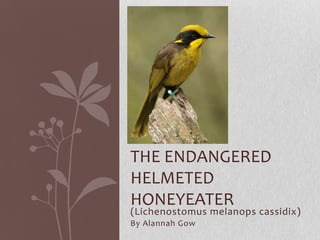
The endangered helmeted honeyeater
- 1. THE ENDANGERED HELMETED HONEYEATER (Lichenostomus melanops cassidix) By Alannah Gow
- 2. Structural characteristics The Helmeted Honeyeater is • A fully very alike to the average grown Honeyeater (m. gippslandicus) helmeted honeyeater’s but the Helmeted Honeyeater length is has a yellow mo-hawk like about 20 cm crown that is more noticeable (tale to tip) and distinctive ear tuffs. and weighs around 32 g. They range in colour from black to olive-brown to yellow and have a yellow crest.
- 3. Functional characteristics • One of the functional characteristics of the Helmeted Honey Eater is that they produce Hydrochloric acid in their stomachs which helps to break down anything they eat eg. seeds and insects. • They also have a functional feature that helps them to save water. It is that they don’t have one tube for ‘liquids’ and one for ‘solids’ it is all rolled into one, they have one tube that does both and that helps to keep the fluids inside longer. They get rid of their wastes products in the form of uric acid and the uric acid is the white bit in the poo.
- 4. Behavioural characteristics • Their breeding season is from early August through to February. • Two eggs are usually laid about two to three times a year. • The female incubates the eggs for about 14 days, then both parents care for the young • The baby Helmeted Honeyeaters become independent forty days after hatching out of their eggs.
- 5. Diet • The diet of the Helmeted honeyeater consists of about 25% nectar but most of it is made up of bark, twigs, tree sap and Eucalypts leaves. Some of the nectar comes from eucalypt flowers (when they are available). Berries are also gathered from bushes such as the Prickly Currant bush. • Insects mealworms, larval stage of beetles and spiders are also an essential part of the Helmeted Honeyeaters diet, because they contain lots of protein.
- 6. Habitat • The Helmeted honey eater only exists in Victoria east of Melbourne. • Helmeted Honeyeaters habitat is narrow bands of swamp or creek vegetation with Eucalypt forests within the Yellingbo Nature Conservation Reserve.
- 7. Threats • The Helmeted Honeyeater was named an Endangered species under the National Environment protection and Biodiversity Protection act in 1999. They where also listed as a threatened species under the Flora and Fauna Guarantee act in 1988 and in 2003 they where classified as Critically Endangered under the Advisory List of Threatened Vertebrate Fauna in Victoria. • Their threats are; habitat destruction from humans and bush fires, weed invasions, Predation of eggs, feral cats, foxes, but there biggest and most common threat is the Bell miner.
- 8. Bibliography • http://www.helmetedhoneyeater.org.au/helmeted_hone yeater.htm • http://www.dse.vic.gov.au/__data/assets/pdf_file/0019/103168/008_Helmeted _Honeyeater_1992.pdf • http://www.cfzaustralia.com/2011/05/rare-helmeted-honeyeater-released- at.html • http://www.russellsastronomy.com/gallery/Nature/Birds/Healesville%20Sanct uary/helmeted%20honeyeater.htm • http://www.environment.gov.au/biodiversity/threatened/publications/recove ry/helmeted-h-eater/pubs/lichenostomus-melanops-cassidix.pdf • http://www.actwild.org.au/animals/honeyeater • http://www.australian-information-stories.com/helmeted-honeyeater.html • http://www.backyardnature.net/birdpee.htm • http://www.dse.vic.gov.au/__data/assets/pdf_file/0004/103396/Helmeted_ho neyeater.pdf • http://www.environment.gov.au/cgi- bin/sprat/public/publicspecies.pl?taxon_id=26011
